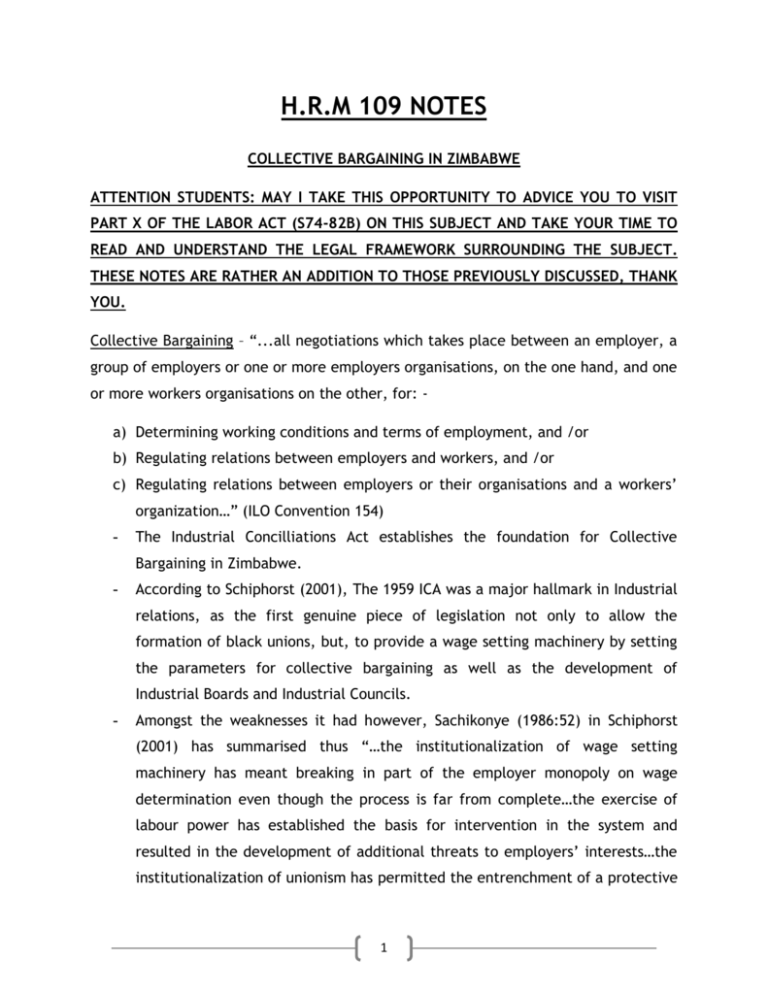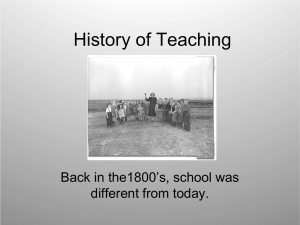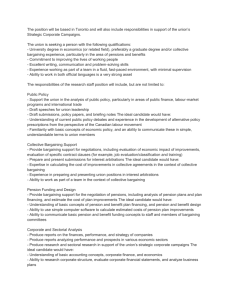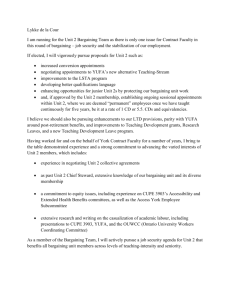hrm 109 notes
advertisement

H.R.M 109 NOTES COLLECTIVE BARGAINING IN ZIMBABWE ATTENTION STUDENTS: MAY I TAKE THIS OPPORTUNITY TO ADVICE YOU TO VISIT PART X OF THE LABOR ACT (S74-82B) ON THIS SUBJECT AND TAKE YOUR TIME TO READ AND UNDERSTAND THE LEGAL FRAMEWORK SURROUNDING THE SUBJECT. THESE NOTES ARE RATHER AN ADDITION TO THOSE PREVIOUSLY DISCUSSED, THANK YOU. Collective Bargaining – “...all negotiations which takes place between an employer, a group of employers or one or more employers organisations, on the one hand, and one or more workers organisations on the other, for: a) Determining working conditions and terms of employment, and /or b) Regulating relations between employers and workers, and /or c) Regulating relations between employers or their organisations and a workers’ organization…” (ILO Convention 154) - The Industrial Concilliations Act establishes the foundation for Collective Bargaining in Zimbabwe. - According to Schiphorst (2001), The 1959 ICA was a major hallmark in Industrial relations, as the first genuine piece of legislation not only to allow the formation of black unions, but, to provide a wage setting machinery by setting the parameters for collective bargaining as well as the development of Industrial Boards and Industrial Councils. - Amongst the weaknesses it had however, Sachikonye (1986:52) in Schiphorst (2001) has summarised thus “…the institutionalization of wage setting machinery has meant breaking in part of the employer monopoly on wage determination even though the process is far from complete…the exercise of labour power has established the basis for intervention in the system and resulted in the development of additional threats to employers’ interests…the institutionalization of unionism has permitted the entrenchment of a protective 1 instrument of working-class welfare, this being not an insignificant achievement in the prevailing climate…”. - The 1973 Act twisted the system of collective bargaining with the empowering of the minister to vary CBAs, thus reducing the freedom to bargain (Collective Bargaining Autonomy). - Not so much change occurred post-independence, as had been forecasted, but just the flow with in the direction of the 1959 Industrial Conciliation Act. Within the first five years of independence, wages continued to be determined through bargaining at an industry level, albeit after the removal of racial overtones. - This period also marked the time to debate on whether to introduce workers committees and works councils in the new system, or instead to strengthen the machinery already present. - To trade unions, this had obvious implications in terms of their strengths, at a time when they believed that the development of a trade union movement was more an important achievement of worker expectations than worker participation, while to business; it meant an alteration to the existing power structures and an opening of new forms of worker control. - That witnessed the formation of enterprise councils and the strengthening of the one-industry-one-union policy. Collective bargaining became largely centralized at the industry level. - The coming in of the 1985 Act witnessed the institutionalization of collective bargaining at industrial level with the possibility of enterprise flexibility through flexibility through workers committees (Schiphorst 2001). - Concepts such as the unfair labor practice concept were introduced, including good faith bargaining, bringing Employment Councils and Employment Boards (in their structures and forms) in the hierarchy to replace industrial councils and boards, that had been introduced in the 1959 Act as well as empowerment of enterprise level bargaining through works councils, the empowerment of the state to promulgate regulations which would have overriding effects on bargaining agreements, state’s determination of maximum and minimum 2 wages, severe curtailment of the right to strike and the intensive state regulation of trade unions as well as the continuation of the one union one industry concept among other things. - This resulted in collective bargaining playing a more secondary and subordinate role to state regulation. - The neo-liberal policies adopted in the 90’s witnessed, but a radical shift towards voluntarism and labour autonomy, when collective bargaining became a decisive platform for the determination of wages and dismissals. - Benefits accrued to labour in terms of full recognition of trade unions as a legitimate patner to the process, though major shortcomings including the severe curtailment of the right to strike as well as shop floor competition that came in the form of works councils. - The 2002 Amendment Act strengthened the facilitative role of the state, which expressly states in the purpose of the Act the provision of a legal framework within which employers and employees can bargain collectively for the improvement of working conditions. - This position has been maintained by the 2006 Labour Act, as provided for on Part 1X (Sections 74 to 82B) of the Act. Some of the critical elements that lie at the core of collective bargaining in the Act include, among other things; issues on the scope of agreements (s74), good faith negotiation (s75), disclosure once inability to pay is alleged (s76), issues of agency representation (s77), registration of agreements (s79) as well as internal and external regulation or variation of agreements (including the powers of the minister to vary the agreements so made-s81). Merits on Employer-Employee Relations. - Collective bargaining law in Zimbabwe has tremendously contributed to the whole industrial relations framework both economically and socially. - The major economic benefit so derived by parties to the employment relationship has been the establishment of a framework upon which individual 3 and collective workplace relations are managed and where industrial conflict is institutionalized for the pursuit of a harmonious employee relations climate. - Gwisai (2006) also acknowledges how law has aided employee relations socially (in terms of justice and democracy) by the strength of S2A of the Act (Purpose of the Act). Collective Bargaining Autonomy, though some argue is limited, remains, but a significant factor that has been enjoyed by parties to Employee Relations. - The legally binding nature of Collective Bargaining has been significant. It falls at the hub of such works like Otto Kahn Freund who argue that law comes as a force to “…regulate, support, and restrain the powers of management and organized labour…” In other words, there is a clear recognition of the power differences between individual employees against management or organized labour against management respectively, the inadequacies of the former (organized labour) to provide a power base that can be equated to that of the later (management) at the bargaining table, which then justifies the need for a machinery to govern their relationship (in terms of setting the framework upon which terms and conditions of employment are regulated). - Furthermore, the law has improved on trade union effectiveness, as measured by the meeting of primary needs of workers such as better pay and conditions, increased influence on what they regard as increased influence on what they regard as workplace decisions, and protection against arbitrary management action (Freeman 1996). This is regardless of whether unions are instrumentally or ideologically motivated to do so. Shortcomings of the law - In as much as the law on collective bargaining has posed improvements on employer-employee relations, it has also had its own weaknesses, or limitations. A critical analysis of one element key to the process, the recognition of a need to balance the powers of the parties to the employee relations, has not been addressed carefully. 4 - The rhetoric of the argument provides a seemingly clear manner in which the government has tried to create a balance of power between parties to employee relations, but the reality is very different. - The state has made it very difficult for labor to enjoy the freedom to bargain by instituting a well calculated and sophisticated bargaining framework involving a combination of bargaining centralization through employment councils as well as bargaining decentralization in the workplace (Schiphorst 2001). - While this may have been simple, if we look at s23 (1) (b), it has become very difficult for unions to gain 50 % membership at an enterprise level so that they could control the workers committees as shop stewards in the workplace with the prevailing economic environment. - This was also made in light of Part VII of the Act on the right to organize, giving rise to a recognition of multiple unions at the negotiation table (usually in opposition with regards to political opinions) for example AMWZ and NUMQISWZ in the mining industry, and most importantly, the continued curtailment of the right to strike, or rather, the exercise of the freedom through a set of verbose procedures and unfounded restrictions (Part XIII of the Act). - Research has clearly proved that the essence of bargaining power lies in one’s ability to withhold something of value to another and that a strike action is an essential and integral part of collective bargaining (Gwisai, 2006). - Without this, “…the power of management to shut down the plant will not be matched by a corresponding power on the side of labour…”. Apparently, such factors have tended to negatively affect trade unions in terms of their powers to negotiate effective collective bargaining. - Most of the regulations were largely driven by political factors rather that economic ones, thus resulting in a disintegrated, frustrated, competing (levels) and conflicting labour movement hense diverting their attention from representing their constituencies to scampering for membership. Meanwhile, this has given more security to employers who already have so much power in employee relations. 5 - A combination of the two tier system of managing collective bargaining, one for the Public Sector and another for the Private Sector, plus the administration of a combination of bargaining centralization (industry-wide) and decentralization (company-wide) simultaneously has also come with it some interesting results. - This has also been against the fact that there are more than 20 sectors/industries negotiating their agreements with employees in the country. - As a result, there has not only been a lack of collective voice on the part of employees in general, but the private sector has had a tendency to wait for the public sector to negotiate CBAs first, and then use the result as a benchmark. Such has been a rather firefighting and retrogressive ploy considering how poorly the public sector has addressed issues of working conditions. - The lack of coordination amongst bargaining centers has also resulted in a lack of a collective voice and an organized strategy with respect to the capacity of industry to produce and pay. - The other weakness was that the declining degrees of bargaining centralization to industry level has tended to result in bargainers passing negative pay externalities (i.e the cost of pay rises in terms of inflation, unemployment and loss of competitiveness) onto third parties (e.g customers, other employee goups and also the state). Now this has equally resulted in the stagnation of the country’s economic performance. - The area of scope of bargaining has not been fully addressed by law to take consideration, explicitly issues of productivity, which should be a critical factor in the consideration of pay increases. - This has resulted in a nadir relationship being built in employee relations where union strength would at times supersede the capacities of companies to pay (for example in the energy industry and local authorities). - The resultant effect has been the channeling of company funds towards employee salaries at the expense of the real objects of Companies. It has been the general public that has felt the grip especially considering how water and electricity charges have increased for example, pressure for payments 6 mounting against a rather dismal performance of these, in terms of service delivery. These companies have managed to comprise market leaders in terms of pay and benefits despite the fact that there is a sharp contrast between productivity and pay, a flaw of the law. At one time the minister even had to interfere in order to get allowances cut for some employees in the energy industry. - Within this context, a great deal of questions has been raised over the effectiveness of Arbitrators in collective dispute management, especially amid reports from business that they were not factoring in these issues of productivity in wage determination. - This has been exacerbated by the continued inclination of the labour movement on measuring minimum wages basing on the basic needs as explained in calculating the Poverty Datum Line thus building on stagnation of the economy by way of creating a dependency syndrome where they focus on milking business of productive funds instead of realizing the relationship between productivity, performance, revenues and pay increases. - A more similar argument has been raised in that the binding effect of collective bargaining agreements on everyone in a specific industry has largely affected many companies in terms of their capacities to pay since they are affected differently by the business environmental factors. The moment we have Companies failing to meet wage payment among other collective bargaining obligations, stagnation, rightsizing elements or even Company closure becomes imminent. - Whilst taking note of the failures of the law to take into consideration the factors that affected collective bargaining after the 2006 Act (esp. 2008) thus shaping the scope of bargaining, where a great deal of both substantive and procedural rules was varied, the frequency of bargaining increased, the levels of bargaining decentralized to the workplace, and coverage of agreements also varied, equally, challenges have been noted in trying to get parties to employee relations re-oriented to a new dollarized Zimbabwe, which is a bit certain and more likely predictable. 7 - The same applies to its failure to take cognizance of the increasingly growing informal sector. - The weaknesses of law on collective bargaining in adapting to the prevailing economic situation has also paved way for the administration of sophisticated HRM practices and an intimate relationship between labour and business that has witnessed new trends on Collective bargaining (to include productivity bargaining elements, e.g, at Wankie Colliery) as well as other agreements that fall outside the legal framework of Collective bargaining in Zimbabwe being binding on parties, for example in 2008. RECOMMENDATIONS - Productivity bargaining should be factored in on the scope of bargaining explicitly, since it lies at the hub of collective bargaining. This should be complemented by an effort to apprise the labour movement of the need to view negotiations within the context of organizational and industry performance. - Trade unions will always remain ineffective for as long as they cannot exercise their right to resort to collective job action as part of bargaining. This is but the most important area that builds on trade union strength and hence forces employers to negotiate effectively. - The law should also put up a clause governing the frequency of bargaining and circumstances upon which agreements can be reviewed in a clear and precise manner. - There is need to reduce the number of bargaining councils so as to try create a platform for the formulation of more homogeneous agreements that allow for internalization of negative pay externalities whilst at the same time allowing for coordination amongst bargaining centers and the mapping of a whole industry-wide bargaining strategy. 8 - There is need for the creation of a legal framework guiding and binding parties to the social contract and then cascading to the workplace through a machinery of collective bargaining. This is largely because the social contract has significant impacts on collective bargaining. REFERENCES Gwisai M,(2006), Labour and Employment Law in Zimbabwe, Zimbabwe Labour Centre, Harare Labour Act, (2006), Government Printers, Harare Mugumisi S,(18 Nov 2009), Collective Bargaining: lessons form from 2009 focusing at 2010 and Regional Trends, Paper presented at the IPMZ Labour Briefing in Harare. Schiphorst F.B,(2001),Strength & Weakness: the rise of ZCTU and the development of Labour relations (1980-1995) Swanepoel et al,(2007), South African Employment Relations, Van Schaik Publishers, Pretoria Taxler.F,(2009), The Economic Effects of Collective Bargaining Coverage:A cross national analysis, ILO, Geneva 9
![Labor Management Relations [Opens in New Window]](http://s3.studylib.net/store/data/006750373_1-d299a6861c58d67d0e98709a44e4f857-300x300.png)




